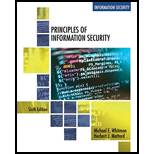
Explanation of Solution
Physical security:
Physical security is giving protection to physical items or objects or even areas from an unauthorized access. That is, it gives protection physically to people, system, hardware and some resources that are connected with the management.
Main threats to physical security:
Some of the threats to physical security are as follows:
- Inadvertent act – These are the potential actions of human error or failure, or any other deviations.
- Deliberate act – It is nothing but the act of spying
- Acts of god – This threat comes because of nature or some
- Technical failures – This threat occurs because of failure in hardware or errors.
- Management failures – Technical obsolescence.
Primary threats are manifested in attacks against the organization:
Inadvertent act – It can be represented by an employee by dropping tea on his/ her laptop.
Deliberate act – This act could be demonstrated by an opponent sneaking into a facility with a camera, or by stealing equipment of a computer or credentials or passwords, etc.
Act of God – This act could be demonstrated when a lightning hits a building or by causing a fire or any other natural disasters.
Technical failures – It can be represented by threat occurs due to hardware failure.
Management failures – Technical obsolescence.
Want to see more full solutions like this?
Chapter 9 Solutions
Principles of Information Security (MindTap Course List)
- Compute a Monte Carlo estimate o of 0.5 0 = L ē -xdx 0 by sampling from Uniform(0, 0.5). Find another Monte Carlo estimator 0* by sampling from the exponential distribution. Use simulations to estimate the variance of Ô and ⑦*, which estimator has smaller variance?arrow_forwardimport tkint class ShowInfoGUI:def __init__(self):# Create the main windowself.main_window = tkinter.Tk() # Create two framesself.top_frame = tkinter.Frame(self.main_window)self.bottom_frame = tkinter.Frame(self.main_window)arrow_forwardJOB UPDATE Apply on- COMPANY VinkJobs.com @ OR Search "Vinkjobs.com" on Google JOB PROFILE JOB LOCATION INTELLIFLO APPLICATION DEVELOPER MULTIPLE CITIES GLOBAL LOGIC SOFTWARE ENGINEER/SDET DELHI NCR SWIGGY SOFTWARE DEVELOPMENT BENGALURU AVALARA SOFTWARE ENGINEER (WFH) MULTIPLE CITIES LENSKART FULL STACK DEVELOPER MULTIPLE CITIES ACCENTURE MEDPACE IT CUST SERVICE SOFTWARE ENGINEER MUMBAI MUMBAI GENPACT BUSINESS ANALYST DELHI NCR WELOCALIZE WORK FROM HOME MULTIPLE CITIES NTT DATA BPO ASSOCIATE DELHI NCRarrow_forward
- How can predictive and prescriptive modeling be used to measure operational performance in real-time? Do you see any potential downsides to this application? Can you provide an example?arrow_forwardTracing the Recursion. Tracing the Recursion. Observe the recursive solution provided below. 1. Which line(s) of this program define(s) the base case of sumOfDigits() method? 2. Which line(s) of this program include recursive call(s)? 3. Trace the recursion below. You must show the trace step by step; otherwise – little to no credit! 4. Show me the final result! 1 public class SumOfDigitsCalculator { 30 123456 7% 8 public static void main(String[] args) { System.out.println(sumOfDigits(1234)); } public static int sumOfDigits (int number) { if (number == 0) 9 10 11 12 } 13 } else return 0; return number % 10 + sumOfDigits (number / 10);arrow_forwardmodule : java 731 Question3: (30 MARKS) Passenger Rail Agency for South Africa Train Scheduling System Problem Statement Design and implement a train scheduling system for Prasa railway network. The system should handle the following functionalities: 1. Scheduling trains: Allow the addition of train schedules, ensuring that no two trains use the same platform at the same time at any station. 2. Dynamic updates: Enable adding new train schedules and canceling existing ones. 3. Real-time simulation: Use multithreading to simulate the operation of trains (e.g., arriving, departing). 4. Data management: Use ArrayList to manage train schedules and platform assignments. Requirements 1. Add Train Schedule, Cancel Scheduled Train, View Train Schedules and Platform Management 2. Concurrency Handling with Multithreading i.e Use threads to simulate train operations,…arrow_forward
- please answer my 2 java questions correctly , include all comments etc and layout and structure must be correct , follow the requirementsarrow_forwardQuestion3: Passenger Rail Agency for South Africa Train Scheduling System Problem Statement (30 MARKS) Design and implement a train scheduling system for Prasa railway network. The system should handle the following functionalities: 1. Scheduling trains: Allow the addition of train schedules, ensuring that no two trains use the same platform at the same time at any station. 2. Dynamic updates: Enable adding new train schedules and canceling existing ones. 3. Real-time simulation: Use multithreading to simulate the operation of trains (e.g., arriving, departing). 4. Data management: Use ArrayList to manage train schedules and platform assignments. Requirements 1. Add Train Schedule, Cancel Scheduled Train, View Train Schedules and Platform Management 2. Concurrency Handling with Multithreading i.e Use threads to simulate train operations, Each train runs as a separate thread, simulating its arrival, departure, and travel status. 3. Use ArrayList to manage train schedules for each…arrow_forwardplease answer my java question correctly , include all comments etc and layout and structure must be correct , follow the requirementsarrow_forward
 Principles of Information Security (MindTap Cours...Computer ScienceISBN:9781337102063Author:Michael E. Whitman, Herbert J. MattordPublisher:Cengage Learning
Principles of Information Security (MindTap Cours...Computer ScienceISBN:9781337102063Author:Michael E. Whitman, Herbert J. MattordPublisher:Cengage Learning Principles of Information Systems (MindTap Course...Computer ScienceISBN:9781305971776Author:Ralph Stair, George ReynoldsPublisher:Cengage Learning
Principles of Information Systems (MindTap Course...Computer ScienceISBN:9781305971776Author:Ralph Stair, George ReynoldsPublisher:Cengage Learning Management Of Information SecurityComputer ScienceISBN:9781337405713Author:WHITMAN, Michael.Publisher:Cengage Learning,
Management Of Information SecurityComputer ScienceISBN:9781337405713Author:WHITMAN, Michael.Publisher:Cengage Learning, Fundamentals of Information SystemsComputer ScienceISBN:9781337097536Author:Ralph Stair, George ReynoldsPublisher:Cengage Learning
Fundamentals of Information SystemsComputer ScienceISBN:9781337097536Author:Ralph Stair, George ReynoldsPublisher:Cengage Learning Principles of Information Systems (MindTap Course...Computer ScienceISBN:9781285867168Author:Ralph Stair, George ReynoldsPublisher:Cengage Learning
Principles of Information Systems (MindTap Course...Computer ScienceISBN:9781285867168Author:Ralph Stair, George ReynoldsPublisher:Cengage Learning





